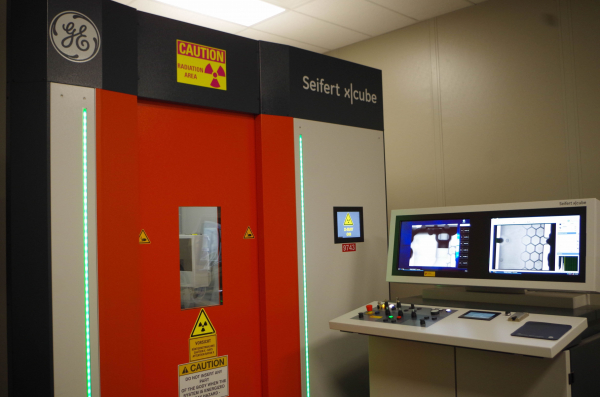Casting X-Ray

Le Sueur Incorporated’s in-house X-ray capabilities, often said to be the most utilized equipment within our facility, allows us to inspect the internal soundness of a casting. We continuously monitor for internal soundness quality that might otherwise compromise the quality of an aluminum casting.
We have (3) X-ray methods at our disposal including Digital Radiography (DR), Computed Radiography (CR) and Film Radiography.
Digital Radiography (DR)
Digital Radiography uses DR Sensors that digitize the radiation passing thru a component creating a digital radiographic image that can be displayed immediately on PC screen.
DR is often referred to as “Real-time X-ray” due to the speed in which a radiographic image can be produced. DR offers the ability to digitally enhance an image for better interpretation. Digital images are easily archived for future reference.
Computed Radiography (CR)
The Computed Radiography process is similar to Film Radiography with the difference being the radiographic film is replaced by a reusable imaging plate. After exposure, the imaging plate is placed in a CR Reader where via laser scan, a digital image is produced. The imaging plate is then optically erased for re-use.
CR has advantages over Film Radiography including lower cost and the ability to digitally enhance an image for better interpretation. Digital images are easily archived for future reference.
Film Radiography
Film Radiography is an imaging technique using X-rays to view the internal features/defects of a casting. An electromagnetic X-ray beam is passed through a subject casting. The majority of the X-ray beam is absorbed by the aluminum castings itself. A small percentage of X-rays will pass through the casting and are absorbed by the radiographic film. The film is processed via a film processor and a film image is obtained.
VOIDS IN ALUMINUM CASTINGS
Porosity is a term used loosely defining any void or hole in a casting. Gas Porosity and Shrinkage are both internal voids in a casting, but much different. Both may result in leak paths and exposed voids on machined surfaces. Unacceptable voids in a casting will result in a casting being unusable for holding pressure or leaking in applications such as pumps, compressors, transmissions, hydraulics and pneumatics.
Gas Porosity
Gas related porosity is caused by air entrapment during the flow of metal in the mold or trapped gases in the liquid metal. Trapped air/gas is dispersed as small spherical like "bubbles" when metal fills the mold cavity. Gas related porosity generally looks like bubbles having a smooth interior.
Shrinkage
Aluminum reduces in volume when cooled and solidified inside the die or mold. Shrinkage porosity is more prone to form in heavy mass or isolated areas of a casting. This is due to thinner sections of the casting "freezing-off", preventing the continued pressure and/or feeding of the heavier mass areas as these areas continue to cool. Sponge Shrinkage will appear to be clouded areas with undefined edges. Cavity Shrinkage will appear to be a jagged, irregular shaped void.
Le Sueur Incorporated specializes in producing dimensionally complex, pressure tight aluminum castings and thermoplastic injection molded components. We offer complete in-house precision machining, finishing and assembly. Please contact us to learn more about our capabilities and discuss your casting project!

